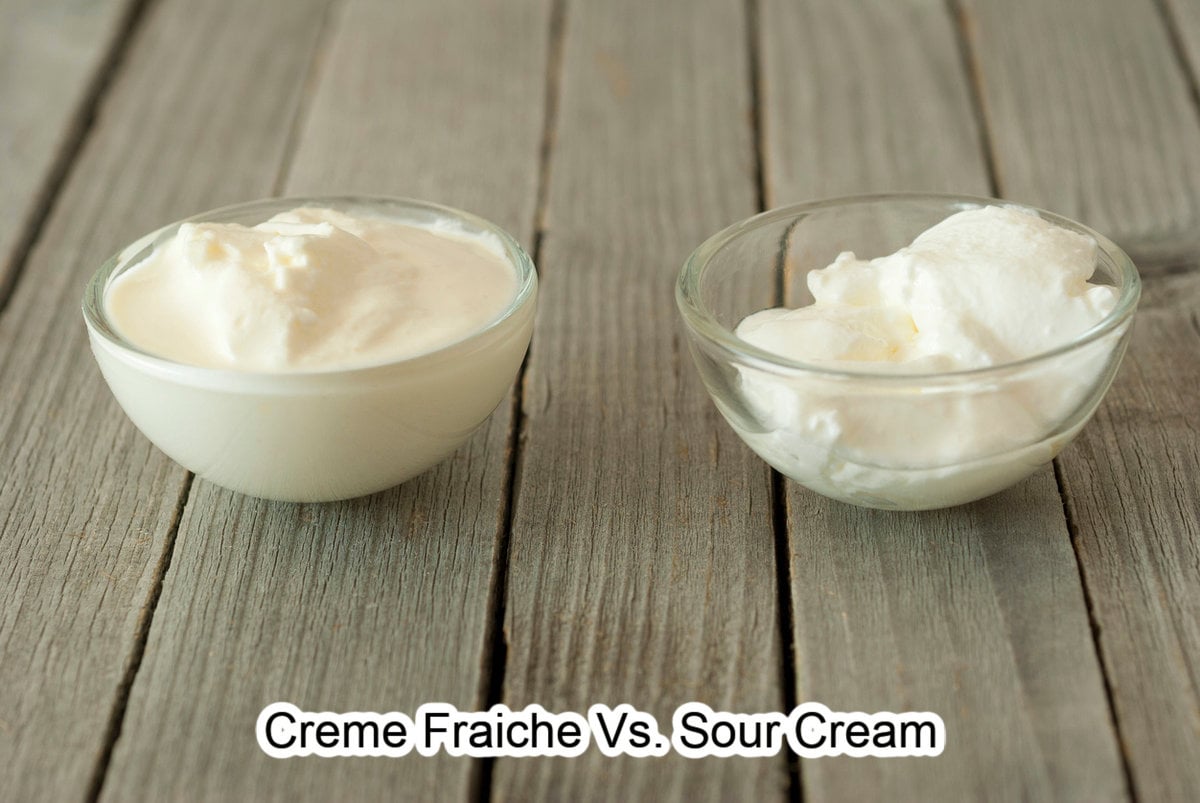If you've stood at the supermarket comparing creme fraiche vs sour cream, you might be wondering what the difference is.

Creme fraiche and sour cream are two dairy products that are often confused for each other.
They have some similarities, but there are also some key differences between the two.
What Is Creme Fraiche?
Creme fraiche is a type of cream that has been cultured and thickened. It is made by adding a bacterial culture to heavy cream. After the culture has time to work its magic, the cream is thickened and has a slightly sour, nutty flavor.
Creme fraiche has a long history dating back to the 12th century. Creme fraiche originated in France and has been used in French cuisine for centuries.
It began as a way to preserve cream but became a popular ingredient in many French dishes. It is used in crepes, onion soup, potato gratin, tart fillings, sauces, and dressings.
What Is Sour Cream Made Of?
Sour cream is a type of cream that has been fermented and thickened. But what's in sour cream? It's made of cream, milk, and bacteria. The bacteria give sour cream its sour and tangy flavor.
Sour cream is made by fermenting fresh cream with lactic acid bacteria. This bacteria converts lactose, the milk sugar, into lactic acid. The lactic acid causes the milk to thicken and sour. This process gives sour cream a tart, acidic taste and a thick, creamy texture.
Sour cream is used as a condiment to top off food items, such as tacos, burritos, and enchiladas. It can also be used in recipes, such as dips, sauces, and salad dressings.
The Difference Between Creme Fraiche and Sour Cream
Creme fraiche and sour cream are similar, but there are 3 main differences between them. They are different in the way they are made, their tastes, and how much fat they have.
1. How They Are Made
Creme fraiche and sour cream are both types of cream that have been thickened. But they are thickened through different processes.
Creme fraiche is made with heavy cream that has been cultured. Sour cream is made with milk that has been fermented.
2. Taste
Sour cream has a tangy flavor, while creme fraiche has a nutty flavor. Creme fraiche is not as acidic as sour cream and has a more subtle flavor.
Creme fraiche is good for recipes where you want the creaminess of sour cream but don’t want the dish to be overpowered by sourness.
3. Fat Content
Creme fraiche has a higher fat content than sour cream. Creme fraiche has a fat content of around 30-45%, while sour cream has a fat content of around 18-20%. The higher fat content in creme fraiche makes it a richer and more flavorful option.
How To Use Creme Fraiche Vs. Sour Cream
When choosing between creme fraiche and sour cream, consider what you will be using it for. If you are looking for a nutty, rich, and creamy topping, then creme fraiche is the better option. If you are looking for something tangier, then sour cream is the better choice.
Using creme fraiche or sour cream in your baked goods adds richness and creaminess to the finished product. It keeps the baked goods moist and adds a bit of flavor.
Creme Fraiche Vs. Sour Cream FAQs
Yes. Creme fraiche can be used in place of sour cream in recipes, but it may not taste as sour. Sour cream can be used in place of creme fraiche in recipes, but it may not taste as nutty.
Sour cream lasts in the refrigerator for about one to three weeks, but it doesn't freeze well.
Yes, creme fraiche and sour cream are both gluten free.
No, vegans do not eat any animal products. Creme fraiche and sour cream are both made from animal milk.
Bottom Line
Creme fraiche and sour cream are both types of thickened cream, but they are made through different processes.
Sour cream is made with milk that has been fermented, while creme fraiche is made with heavy cream that has been cultured.
Creme fraiche has a higher fat content than sour cream and a nuttier flavor.
Both sour cream and creme fraiche can be used interchangeably in recipes, but they will not give the exact same flavor.


George says
"Traditionally, both crème fraîche and sour cream are made in the same way: By allowing raw heavy cream to ripen, or sour. At warm temperatures (about 70°F to 90°F), bacteria convert lactose (milk sugar) into lactic acid, which both thickens the cream and adds a pleasantly sour tang. The texture and flavor of traditional-style sour cream depends on the temperature and the length of fermentation." Alice Waters Masterclass
The Real difference is FAT CONTENT Creme Fraiche is MUCH HIGHER.